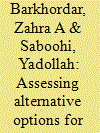| Srl | Item |
| 1 |
ID:
126619


|
|
|
|
|
| Publication |
2013.
|
| Summary/Abstract |
The present paper focuses on medium-term effects of alternative windfall management strategies for a resource abundant country where the resource revenues are expected to last over a prolonged period. In particular, the trade-off between spending and saving is analyzed within the framework of a recursive dynamic computable general equilibrium model. The model is further validated against historical data available for 2001-2010. The total factor productivity is calculated endogenously in the model based on a function that reflects the changes in factor productivity.
The results suggest that saving oil revenues, whether in an oil fund or through physical investment in domestic sectors, leads to a higher economic growth. However, physical investment is superior in the short to medium term based on the resultant GDP while creating an oil fund might be more beneficial in the post oil era.
|
|
|
|
|
|
|
|
|
|
|
|
|
|
|
|
| 2 |
ID:
166304


|
|
|
|
|
| Summary/Abstract |
Energy efficient lighting confers significant potential in electricity demand reduction. To increase the diffusion of energy efficient lighting, an LED Replacement Lamps Program is proposed. Free of charge LED lamps are suggested to be distributed to households by government to reduce household electricity demand. Because electricity is heavily subsidized in Iran, the direct benefit of the program for the government will be avoiding the energy subsidy payments. Back-of-the-envelope benefit cost analysis suggests that if potential electricity savings are realized, the program will be profitable. However, the possible rebound effect may negatively impact the program effectiveness through partially offsetting the potential electricity savings. Therefore, the viability of the program depends on the actual electricity savings that may differ from its anticipated levels. A hybrid dynamic general equilibrium model is employed to evaluate the actual economy-wide energy savings. The model has the novelty of endogenously calculating useful energy demand (e.g. lighting, cooling). Energy demand is then derived based on end-use efficiency and useful energy demand. Model results indicate an average economy-wide rebound of 43.8%. Even though the rebound value is high, the program is shown to be profitable.
|
|
|
|
|
|
|
|
|
|
|
|
|
|
|
|